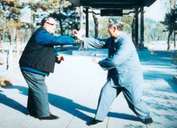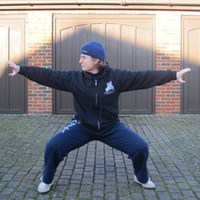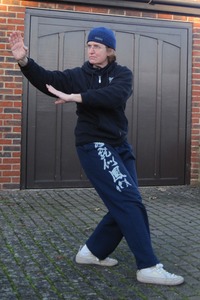2.1 This is the most fundamental of all the fundamental skills. If you can't do the dragon form single palm change properly then you will have the same trouble with every other method and technique. It trains the koubu and baibu steps (stepping firmly and settling firmly into the stances), snake form coiling (horizontal action and connection of the arms through the body), entering with the body (keeping the body upright and moving from the feet). Almost all the major fighting techniques of the system are in and grow from the single palm change.
Focus on the feet, keep the body upright, and do not allow the movements to distract you into the arms. You must do the movement accurately and feel yourself what and why it is accurate. You cannot just do it by rote, following instructions.
The characteristics of the single palm changes are: It moves like a snake, with many changes but always very calm. The body is always centered and upright, and the upper and lower back are open. The whole body moves as one – the inner and outer movement is together as well. The movements affect the inner body, so that there is a feeling of comfort, not fatigue. The stances and movements are big and open, with full qi and spirit. The movements open up the body, the qi, and the spirit. It is not enough that the body is centered and upright – the qi must also be centered, and the internal and external united. This is not just a requirement – it is the essence.
The eight variations of the single palm change isolate particular techniques such as chuanzhang, movement to the eight directions, and vary the upper, middle, and lower basin.
Movement Names: Close The Door With The Elbows, Push The Shutters To Gaze At The Moon, Gather Up The Enemy On Horseback, Hide A Flower Under A Leaf, Green Dragon Turns Its Body.
Description: starting in dragon form with the left hand up.
Action One: Koubu the right leg so that the foot lands across its walking line, pointing to the centre. Touch the toes to the outside of the left foot's line, not across it. Settle firmly into the right leg. Cut the arms across without appreciably changing their position relative to the torso. Rotate the left hand to palm up, or leave it bracing out with the palm down. The right hand may rotate palm up or may stay palm down. Keep the body upright, be careful not to lean when moving in to this narrow stance. Settle into the stepping leg as soon as it steps, so make sure that the angle and placement of the foot is correct. This give power to the technique and sets up for a stable baibu. Complete the action as one unit – legs, arms, and body arrive together.
Action Two: Turn the left arm palm down. Baibu the left leg to a mabu on the arc of the circle, onto its line. Brace out with both arms, still not appreciably changing their position relative to the body. The upper hand is at eye height, so that you naturally stay upright. In this way the whole body braces, not just the arms. Align the left arm with the outer leg. Keep the right arm curved around the body, the hand at the left elbow. Complete the action as one unit – legs, arms, and body arrive together. The mabu is low to develop square power, but the thigh is not quite parallel to the ground. The point is not to see how low you can get, but to develop the power of a cat. The mabu is set into the ground, heavy, centered and stable.
Action Three: Stay in horse stance. Reach the right hand back so that both arms are aligned with the arc of the circle, just outside the line of the horse stance. Keep the left arm extended out to the left side. Then tuck the hand, palm up, to the ribs. Do not separate the body during this movement. (this action is optional)
Action Four: Settle into the left leg and set the left hip before stepping. Step the right foot into koubu and curl the body closed like rolling a leaf. The right hand is already on the body, so bring it along on the body to the left armpit (the hand is always on the body, it does not move to the other arm). Turn as much as possible, stabbing the right hand towards the centre of the circle. Grip the ground with the feet and settle well onto the right leg. Keep the left arm extended above shoulder height (do not coil it in towards the body, this prevents you from turning and allows the power to collapse). Keep the body upright. Look at or past the hand under the armpit.
Action Five: Turn the body back around the other way towards the centre of the circle and allow the arms to come around naturally, gradually turning the palms up. Thread the right hand out along the left arm – do not bring the left arm in to 'help out'. As you thread the hand out, tuck in the elbow. Keep full power, this move trains the whole body power while turning. Be sure to turn and coil the body and bring the arms along, do not start the movement with the arms. Follow the movement of the arms with the head and eyes. Do not move the feet, but shift onto the left leg.
Action Six: Take the dragon form, turning further. Push from the lower hand to twist in and down into the position. Do not raise the stance and do not twist the body from the ribcage. Place the hands and the right foot at the same time. Then start to walk, lifting the inside foot to step first.
Video of Andrea doing the first and second palm changes.
The variations of the change are not in any specific order. They are numbered for convenience and this order may be adjusted later.
In addition to the variations, there are also eight variations of the main techniques that are within the first palm change. For example, tanzhang, chuanzhang, fanbeichui.
- video of first and second dragon palm changes, Andrea Falk 2009
- 1. First variation of the first change (dragon)
- 2. Second variation of the first change (dragon)
- 3. Third variation of the first change (dragon)
- 4. Fourth variation of the first change (dragon)
- 5. Fifth variation of the first change (dragon)
- 6. Sixth variation of the first change (dragon)
- 7. Seventh variation of the first change (dragon)
- 8. Eighth variation of the first change (dragon)










